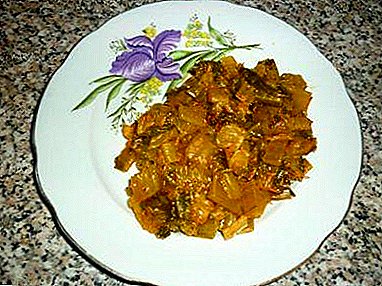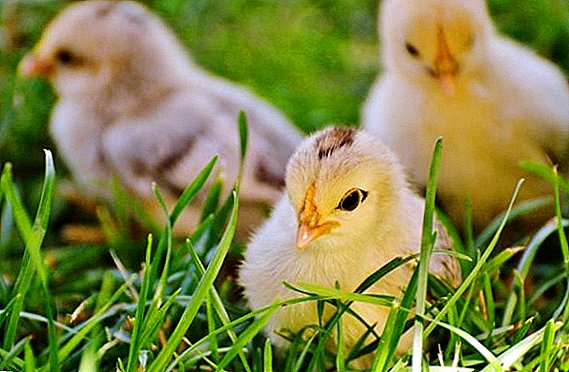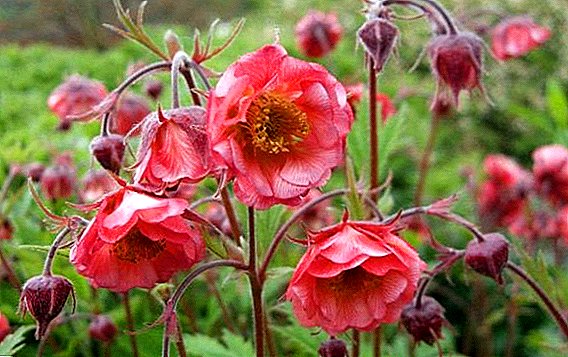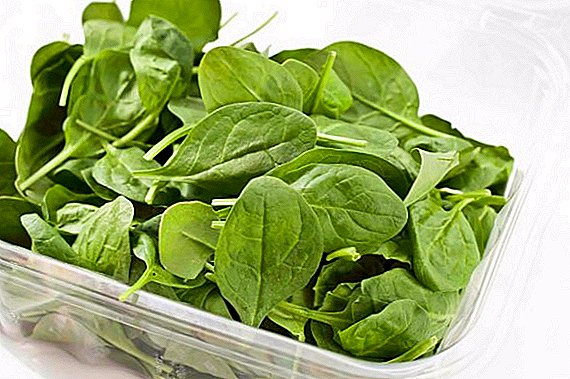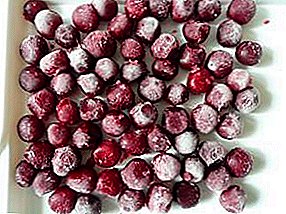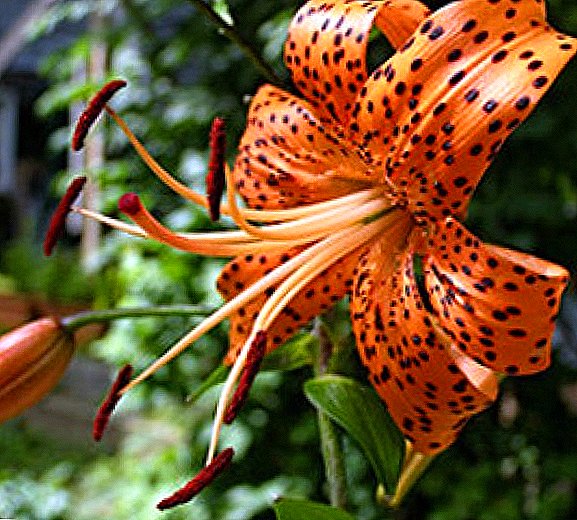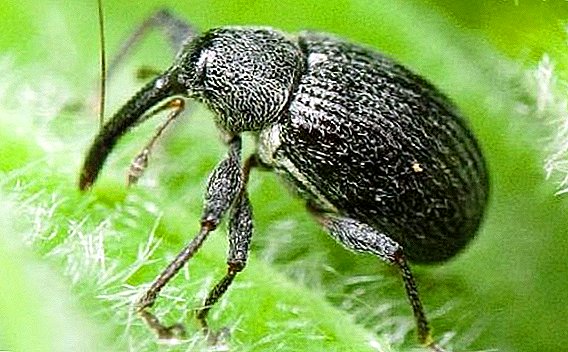 Our garden and the garden are teeming with various pests that feed on cultivated plants or spoil the crop. These pests include weevil, which will be discussed in the article. Familiar to everyone as a “pest of barns”, it can also destroy green spaces, so you need to learn more about the beetle in order to quickly and correctly destroy it.
Our garden and the garden are teeming with various pests that feed on cultivated plants or spoil the crop. These pests include weevil, which will be discussed in the article. Familiar to everyone as a “pest of barns”, it can also destroy green spaces, so you need to learn more about the beetle in order to quickly and correctly destroy it.
Weevil: Meet the Enemy
Weevil, or "elephant beetle" - an insect from the order of beetles. This is a small bug, which has a length of several millimeters, but there are individuals up to 3 cm in length. The color and shape of each species varies, and since the weevil species is only about 5 thousand in the CIS, it is not possible to describe each one.
The family is divided into two extensive subgroups: long-haired and short-haired.
Long-nosed weevils. The beetles of this group have a very large proboscis, which can reach body length. This proboscis is used to pierce a larger layer of tissue. The larvae develop and feed inside the plant tissues. 
Short-crested weevils. These insects are less dependent on the absorption of nutrient juices from plants. They are more "universal", their structure allows you to eat both living vegetation and harvested planting material. The larvae develop in the soil. 
Did you know? Most weevils feed on plants, and only a few in the form of food consume decaying organic residues.
Weevil lays a considerable "army" of larvae, which from birth begin to harm crops and plantings.
It is important to know not only what weevil looks like, but also to recognize its larva. The larvae of the beetle are very small, painted white with a brown head and noticeable jaws.
It looks like a small caterpillar, but the main difference from the "offspring" of butterflies is the absence of limbs. The larva has no legs.
Sometimes the larvae can be painted gray or brown. This is typical of weevils whose larvae feed directly on the leaf surface. If the weevil larva develops in the ground, then the plant roots serve as food for it.
Weevil species and the harm they cause
You learned what weevils eat from the previous section, but each individual species of beetle affects different cultures. To properly deal with the pest, you need to identify it.
Why is the weevil so dangerous? This insect eats everything, from the roots to the inflorescences. Both adult and larvae will harm your landings. Even a small colony of beetles with a trunk can destroy the entire crop of strawberries, raspberries or apples.
And if this parasite gets into the barn, then over the winter you will lose a lot of grain. Particularly severe damage will be noticeable where the grain is stored for subsequent sowing, as the spoiled planting material simply does not germinate.
 First on our list granary weevilwho likes to settle in storage facilities with cereals. The insect is about 4 mm long, has a small proboscis and is colored dark brown. The beetle destroys not only cereals, but also maize, buckwheat, peas and other crops that are harvested from the fields. The fight with this parasite is carried out at the state level.
First on our list granary weevilwho likes to settle in storage facilities with cereals. The insect is about 4 mm long, has a small proboscis and is colored dark brown. The beetle destroys not only cereals, but also maize, buckwheat, peas and other crops that are harvested from the fields. The fight with this parasite is carried out at the state level.
Important! Barn weevil is different from rice and corn, which feed exclusively on the "profile" plant.
 Striped nodule weevil - A parasite that feeds on legumes. The beetle eats all the plants that belong to legumes (peas, beans, soybeans, lentils, and others). The beetle is dangerous because an adult individual destroys the green part of the plant, and the larvae eat the roots. And if we add to this “appetite” the fertility of the females of the striped weevil, which lay about 3 thousand eggs per season, then this pest becomes incredibly dangerous.
Striped nodule weevil - A parasite that feeds on legumes. The beetle eats all the plants that belong to legumes (peas, beans, soybeans, lentils, and others). The beetle is dangerous because an adult individual destroys the green part of the plant, and the larvae eat the roots. And if we add to this “appetite” the fertility of the females of the striped weevil, which lay about 3 thousand eggs per season, then this pest becomes incredibly dangerous.
Fruit weevils. This group includes pests of fruit crops. They eat everything that grows on a tree, including the bark. Incredibly dangerous pests do not just deprive the crop, but also cause serious damage to the tree.
Gray Bud Weevil - A parasite that feeds on buds, leaves and buds of fruit crops. The beetle is colored silver-brown, its length is up to 6 mm. The larva of this beetle develops in the ground, so the trees suffer from damage to the root system. 
Drupe Weevil - beetle that parasitizes on cherry and plum. The adult individual feeds on the buds and leaves of the trees, and the larvae develop inside the fruit, in the bone. The size of an adult individual is 4.5 mm, the color is brown-brown. 
Important! At risk are many fruit trees, such as apricot, quince, plum, apple (apple weevil), pear, viburnum, peach and others.The last group - pests of vegetable crops. Weevils that parasitize vegetables destroy entire fields like locusts. The parasite is so strong that it is often necessary to close hectares of landings in quarantine.
Cabbage Concealed (Weevil) - beetle that parasitizes on cabbage, turnip and radish. Different insect subspecies can eat either the green part of the plant, or the roots and the root itself. The beetle has a length of 3 mm, is painted in dark gray. 
Gray beet weevil - A parasite that destroys corn, sunflower and beets. It should not be confused with the barn, which feeds on harvested corn: this member of the family feeds on young shoots, completely destroying weak plants.
The females of gray weevils, although they do not differ in fecundity, live for 1.5-2 years, which means that a parasite can harm your plantings for two seasons. It is very difficult to notice a beetle, as it is colored gray-brown and has a length of only 1.2 mm.
This group also includes the Indian potato, eastern, common and striped weevil. 
Preventive and agronomic measures against the pest
It is rather difficult to carry out preventive measures against the pest if both fruit crops and vegetables grow on the site, since individual groups of plants will infect different types of weevil.
The most dangerous pest of the collected crops is the barn weevil. In order to prevent the occurrence of the pest beetle with a proboscis in your storage, you must follow the instructions.
- Before storage, products must be heated or cooled, as the pest is afraid of sudden changes in temperature.
- Good drying (weevil likes wet grain).
- Full-fledged cleaning of grain from debris and impurities, which most often the beetle and falls into the barn.
- Pretreatment of the premises with preparations based on phosphorous hydrogen.
Important! The granary weevil does not like harsh smells, therefore, if the beetle was wound up in a small warehouse, it can be driven away by garlic, lavender, or bay leaf.In order for weevils not to appear on the site that affect legumes, you need to adhere to preventive measures:
- during planting, carefully dig and loosen the ground to destroy the larvae;
- remove weeds from the plot;
- conduct early sowing of legumes;
- to delimit the plot (plant perennial away from annual plants).

- Planting fruit crops away from wild plants in a well-drained place.
- Set the "trap belt" on each tree during the swelling of the kidneys. The bark is cut from the trunk so that the beetles cannot crawl inside the bast, and the place of the cut is wrapped with double-sided tape. Another option is paper smeared with glue; such a “belt” well stops the movement of the pest on the tree. After flowering, the belt is removed and burned.
Important! The adhesive belt stops not only the weevil, but also beneficial insects, therefore it should not be installed without a reason.
- Whitening with lime milk at the beginning of kidney swelling. It is necessary to whiten the tree crown, since whitewashing the root part of the trunk will not have any effect.
- Autumn cleaning of the trunk from the old dead bark and whitewashing bare spots.
It is important to understand that the weevil often visits those areas that are not properly looked after. The presence of rotten debris, the lack of a seed shift and too thick plantings lead to the appearance of a pest.
Mechanical method of struggle
Since the parasite is small and multiplies rapidly, removing it mechanically is extremely difficult. Even in a small barn there can be more than a thousand beetles, therefore, it is pointless to remove them one by one.
The mechanical method makes sense when you fight a pest on small plantings of fruit trees or vegetable crops.
So, for example, weevil on strawberries is easy to detect and assemble by hand. The same actions can be done with fruit trees. Sheets of paper or newspapers need to be spread out around the tree and with particular diligence to shake off parasites from leaves and shoots. After the procedure, weevils are burned with paper.
Did you know? The mouth apparatus of the weevils is located at the very end of the tube and has very small dimensions. It is impossible to gnaw at them, so the insects use it like a gimlet.
Fighting weevil by folk methods
Folk remedies - another way to get rid of the weevil.
There is a species of weevil that devours raspberries, strawberries, strawberries and blackberries. Beetle can be destroyed by folk methods that involve a safe method of getting rid of the parasite.
- A solution of laundry soap with mustard. At 5 liters of water take 100 g of soap and 100 g of ground mustard. Spray need a week before flowering. After 10-12 days, the procedure is repeated.
- Infusion of onions and celandine. In a three-liter jar, 2 parts of onion peel and 1 part of celandine (stalks and leaves) are laid. The vessel is 1/3 filled with boiling water. After cooling, the infusion filter and use for spraying without additional dilution with water.

Raspberry-strawberry weevil after such measures of struggle must leave the plantations.
Fruit weevil can be derived using decoctions and infusions.
- Infusion on the field daisy. It is necessary to collect about 150 inflorescences and fill them with 10 liters of water. A day later, infusion filter and add 60 g of soap.
- A decoction of tomato tops. Immediately after flowering, the tops of the tomato are harvested (about 1 kg will be needed for the decoction) and boiled in 10 liters of water for 30 minutes. Next, add 40 g of soap to the broth and spray the fruit trees.
Important! Folk remedies for weevil should be used only in cases where infection not is massive. If the weevil multiplies faster than dying from any means, then there is no point in spraying.In order to prevent the destruction of pea planting or bean weevil, it is necessary to treat the legume crops with the following extract: put onion peel, garlic peel and needles in a large container; the container is filled with water and left to ferment for 2 weeks, then it is diluted with water 1:10 and sprayed on the planting. It is necessary to carry out processing once a week.
Most of the folk "drugs" are composed of bactericidal components (onions, garlic, needles), so you can prepare your infusions and decoctions based on them if you do not find the necessary type of weevil in this article.
Fighting weevil by biological methods
Biological control techniques are the use of other animals or organisms that eat or expel weevil from the site.
Important! The biological method of dealing with the weevil cannot be used in tandem with chemistry, since most of the natural enemies of the beetle will be destroyed by drugs.
 It is worth starting with ants. There is a variety of insects that are used to destroy the weevil on plantings. However, it is worth remembering that ants can bring aphids to your site, so their usefulness is rather doubtful.
It is worth starting with ants. There is a variety of insects that are used to destroy the weevil on plantings. However, it is worth remembering that ants can bring aphids to your site, so their usefulness is rather doubtful.Birds. Winged friends are always happy to help with the destruction of uninvited guests. To help the birds get rid of weevil, you need to place a few feeders near the affected plants. So you can not only revive your garden with singing, but also get rid of a small population of the pest.
 Ground beetles This insect predator eats not only weevils, but also other pests of the garden. It looks like a ground beetle of a medium size, which has a matte black color of the whole body. These bugs are very useful, but it is quite difficult to buy them, so it is impossible to breed good insects.
Ground beetles This insect predator eats not only weevils, but also other pests of the garden. It looks like a ground beetle of a medium size, which has a matte black color of the whole body. These bugs are very useful, but it is quite difficult to buy them, so it is impossible to breed good insects.
Did you know? There are about 70 thousand species of weevils in the world, and every year more and more new species are discovered, most of which inhabit tropical countries.
Fighting with Heavy Artillery: Spraying Chemicals
Pesticide treatment is a reliable means of getting rid of the weevil. It is necessary to use toxic chemicals only if your plantings are completely covered with weevil, or if this beetle destroys tons of harvested grain.
In any other cases, the use of "heavy artillery" is not recommended, in order to avoid total destruction of all life on your site, poisoning of soil and fruits.
Since the weevil is an insect, insecticides are used to destroy it. Regardless of the type, color and size, the insecticide will kill any parasite.
However, it should be understood that different cultures react differently to the pesticide.
The most affordable and effective insecticides: "Fufanon", "Kemifos", "Novaktion", "Alatar", "Pochin" (to destroy the larvae), "Mospilan" and others.
In order for the insecticide to cause minimal damage to the plant, it must be used exactly as instructed, since different dosages are required for different crops. Knowing who the weevil is and how dangerous it is, you need to take up its complete destruction or reduction of the population in time.
We recommend not to use strong drugs in the event that losses from the activity of the weevil are insignificant, because you can poison the entire crop or destroy the entire microflora on the site. Use our tips to protect planting and harvesting from weevil.


